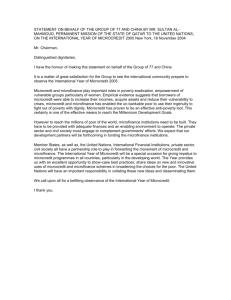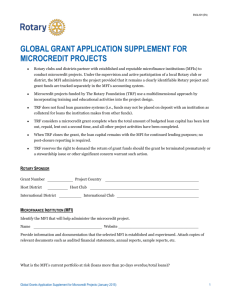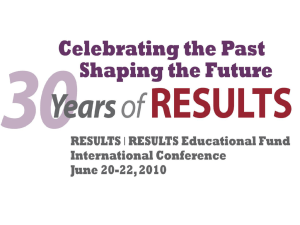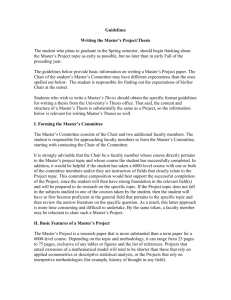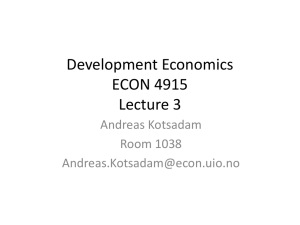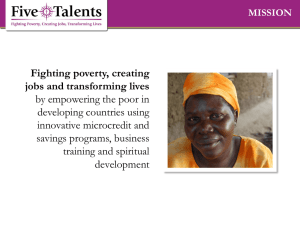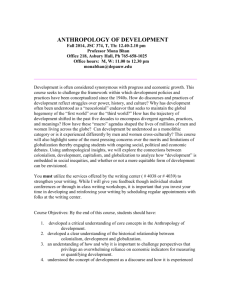Overlapping and Information Systems in Microcredit: a Bangladesh
advertisement
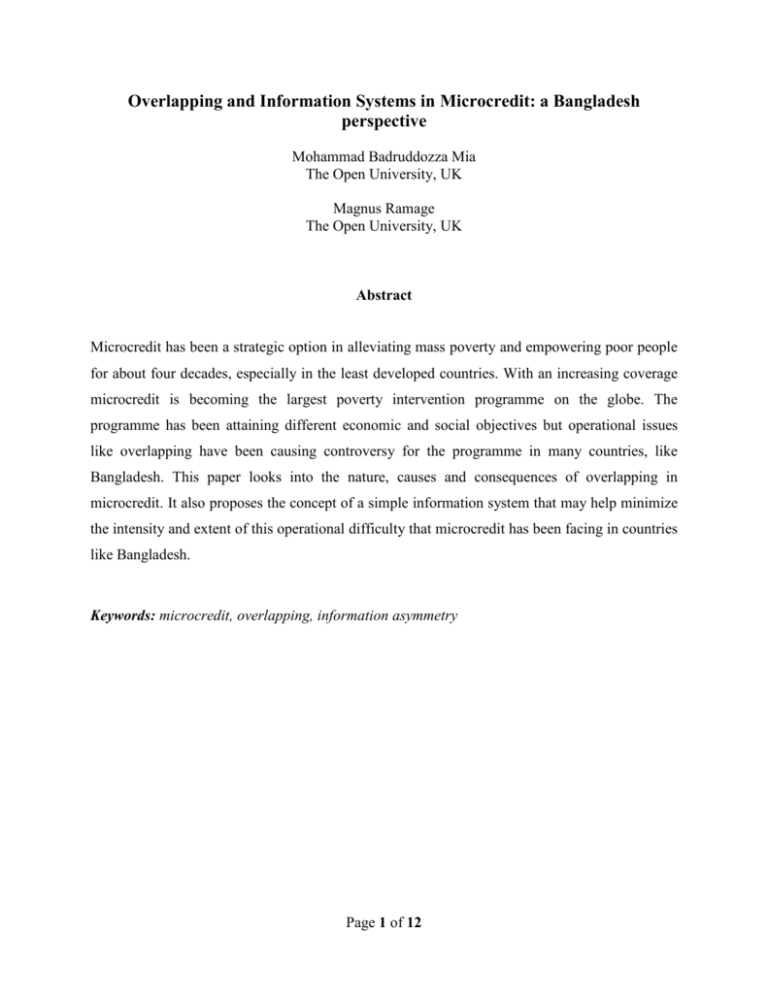
Overlapping and Information Systems in Microcredit: a Bangladesh perspective Mohammad Badruddozza Mia The Open University, UK Magnus Ramage The Open University, UK Abstract Microcredit has been a strategic option in alleviating mass poverty and empowering poor people for about four decades, especially in the least developed countries. With an increasing coverage microcredit is becoming the largest poverty intervention programme on the globe. The programme has been attaining different economic and social objectives but operational issues like overlapping have been causing controversy for the programme in many countries, like Bangladesh. This paper looks into the nature, causes and consequences of overlapping in microcredit. It also proposes the concept of a simple information system that may help minimize the intensity and extent of this operational difficulty that microcredit has been facing in countries like Bangladesh. Keywords: microcredit, overlapping, information asymmetry Page 1 of 12 Introduction Fighting against poverty has long been going on through the concept of providing small amounts of money as a collateral free loan to economically marginalized communities which have no access to formal financial services. One of the main underlying assumptions of the concept is that the receiver of the money will be able to uplift the economic condition of the household through creating self-employment with this manageable amount of money. The concept also includes the belief that through involvement of lending-repayment process with different sociocultural activities, empowerment and social development would take place in the community, especially for women (Yunus, 1998). Since the innovation of this concept in the 1970s with the name of microcredit a tremendous movement of implementation of the concept has occurred especially in the least developed countries throughout the globe. It is said that no single poverty intervention programme has ever reached such a wide coverage anywhere in the world as microcredit (Ahmed, 2004). In view of the contribution of microcredit, the UN proclaimed the year 2005 as the International Year of Microcredit, and the Nobel Peace Prize for 2006 was awarded to the pioneer of the concept (Prof Muhammad Yunus) and his organization (Grameen Bank) through which he started implementation of it. Bangladesh, the birth place of microcredit, is one of the countries where the impact of the microcredit programme is massive. With a momentum of intervention in the 1990s, the present coverage of the programme stands about at one-third of rural households of the country through several hundreds of small to giant microcredit organizations yielding rather mixed impressions about the impacts of the intervention. Because of the complex functions of other social, political and economic factors on the same community of microcredit borrowers, ambiguities remain about the process of assessing the exclusive impacts of microcredit intervention. However, reducing poverty through employment generation, boosting the velocity of money in the rural economy, the elimination of traditional local moneylenders with extreme interest rates and social domination, and empowering women in traditional male-dominating society, are some of the major recognized impacts of microcredit interventions in Bangladesh. The concept of microcredit is very much logical, but uncontrolled intervention can disrupt the good features of this concept. In Bangladesh the microcredit programme has been suffering from the problem of overlapping that has a pivotal role and causes many other problems in this very Page 2 of 12 large sector, making the microcredit sector questionable (Chaudhury and Matin, 2002; Charitonenko and Rahaman, 2002). In microcredit the term overlapping is used to refer to the case where one microcredit borrower is given loans by more than one microcredit provider in the same lending period. With this apparently simple definition, overlapping causes a complex situation in this collateral-free lending system for people who are economically vulnerable and incapable of using money received from different sources for income generating activities. This paper describes scenarios of overlapping, its causes, controlling attempts and reasons for failure, and a concept of an information system in its country-context that is intended to help reduce the intensity and extent of overlapping in microcredit within countries like Bangladesh1. Overlapping in Microcredit Sector Unlike the formal financial sector, microcredit is a collateral-free lending system for the poor. As it does not require any documentary collateral, the microcredit borrowers can take multiple loans within the same repayment period from different microcredit organizations, and even different lending points or providers of the same organization, if the borrower is able to hide information about previously-taken loan(s). The conceptual model of microcredit does not require documentary collateral against credit, as the targeted community is assumed not to having this type of collateral. As the documentary collateral is not needed, hiding information about current loan(s) is easier in getting future loans within the microcredit system. On the other hand, the conceptual model also suggests that the microcredit borrower should not be provided with more money as credit from one or different sources that the borrower household is incapable of using in income-generating activities. This paradox in the conceptual model of microcredit is an aspect that must be managed in its operational model in order to attain the objective of microcredit. However, the microcredit operation has failed in managing this issue in countries like Bangladesh. 1 This paper is an outcome of the ongoing PhD research of the author on information systems in microcredit organizations. The study is conducted following the multiple-case study research method with interpretive epistemology (Stake, 1995; Yin, 2003; Orlikowski, 1991). Data has been collected mainly using semi-structured interviews, FGD (Focus Group Discussions), participant observations and document review from six microcredit organizations (ranging from small to very large)in Bangladesh. Page 3 of 12 Through information hiding, overlapping in microcredit can follow different patterns: 1) one borrower can take more than one loan from different microcredit organizations, 2) the borrower can take more than one loan from two branches of one microcredit organization, 3) the borrower can take loans from different staff members of one branch, 4) one borrower can take loans from one or more organizations showing other members of the borrower-group, 5) multiple members of one household (whose incomes and repayments are jointly accounted for) can take loans from single or multiple organizations where credit worthiness is estimated combining the total income of the household during disbursement of each member’s loan by the different loan providers. All these patterns of overlapping exist in the microcredit sector of Bangladesh with a majority of cases following pattern 1. In Bangladesh there are no official statistics available on what proportion of microcredit borrowers are overlapped. There is no mechanism of information systems in place from which the number can be found. It is not even possible to find the overlapped proportion with a conventional survey as a considerable number of overlapped borrowers try their best to hide overlapping information using different interesting information hiding techniques. However, with this interpretive study the understanding of the author from the focus group discussions (FGDs) and interviews with microcredit frontline staff members who are directly involved with the borrower-community is that less than 20% borrowers have a single loan, with some regional variations. The intensity of overlapping is much higher in Southern parts of the country than the North because of human characteristics, geographical and demographic differences. According to the impression of directly involved microcredit staff members, the majority of overlapped borrowers have 2 to 4 loans, although the evidence of extreme cases like one person used to maintain 90 passbooks of different organizations (falls into the pattern 4 of above mentioned patterns) were also found in the near past. However, a few senior level managers of the microcredit sector see the overlapping as a risk sharing arrangement of loans among the loan providing organizations. They think that the total requirements of the money of the borrower are provided by different organizations. The understanding of the present author regarding this interpretation is that this thinking comes from the inability of assessing credit need and creditworthiness of borrower, and from the tendency of maximizing profit through maximum disbursement, making the microcredit sector shaky. Page 4 of 12 Most of the frontline staff of microcredit organizations say that they usually provide a loan to borrowers who have one loan with another organization, if they find that borrower household is capable of repaying two loans in the same period of time. In most cases they do not face a problem with this segment of overlapped borrowers. The discussion of this paper is mainly about the segment of overlapped borrowers who are involved with loans of more than this tolerance limit, obtained through information hiding. Some contextual factors leading to overlapping In an uncontrolled environment and highly demanding large microcredit market with high interest rates in the form of flat-rate calculation, not understandable to most of the microcredit borrowers, a huge number of local and mid-range microcredit operators came into the field with a profit making objective during 1990s in Bangladesh2. There was no regulatory authority effective in the field to control the environment of this large and distributed financial market in the country. As a result an unhealthy competition among microcredit operators emerged during that time, taking probable borrowers into the grips of a higher degree of overlapping (McIntosh and Bruce, 2005; Chaudhury and Matin, 2002). Since the 1990s this competition has been going on, increasingly until at least the late 2000s. With the establishment of the MRA (Microcredit Regulatory Authority) in 2006 by the government, the pace of competition might be getting lesser but it is still out of control. However, the senior management of microcredit organizations and PKSF (the apex financing body of microcredit) believe that a considerable number of poor and moderately poor are still out of microcredit coverage. This segment of people does not have access to the formal financial sector of the country and do not like to go to microcredit operators with the fear of social degradation. In any case, this segment is not coming into the analysis of completion as they are out of microcredit market. 2 A terminological clarification - throughout the paper the term microcredit is used instead of microfinance. Microcredit is the original name of the programme that has been replaced with the term microfinance by most of the writers and practitioners these days as the programme includes components like micro-savings and micro-insurance with microcredit. The subject area of this paper is about only microcredit not the other components of the whole programme. Because of the analysis of the paper is on the credit component of the programme the original and representative term microcredit is used throughout the paper. Page 5 of 12 It is an invariable impression of microcredit staff members who work directly with the borrower community that the supply of microcredit is much higher than the real demand of it in the borrower community of most parts of the country. The term real demand is used here to mean the amount of money that the borrower is able to use for income generation activities. Availability of loan money at a greater level than this amount might be used for non-productive expenses, making the borrower weaker in repaying the loan with interest. However, it is important to mention here that there are a considerable proportion of microcredit borrowers who do not take loans more than the capacity they can use in income generating activities, even if the loans are available. Conceptually, microcredit is a demand-driven poverty alleviation programme. However, maybe with a few exceptions the microcredit operation in Bangladesh is largely disbursement targetdriven. Everyone involved in microcredit operations in different levels of the organization is given targets of loan disbursement. In many cases this is with incentive-disincentive arrangements for the performer in order to make profit of which the exterior term is sustainability. Instead of fixing the target based on the real demand of the credit and the market share of the organization in a specific area this disbursement-target driven microcredit operation is taking place in almost all organizations in Bangladesh. So everyone, starting from the frontline staff members, always run to achieve the target of disbursement, and this target driven lending leads to overlapping. Consequences of overlapping In microcredit, the amount of investment by the borrower in income generating activities is limited by the capability of the poor and in most cases illiterate borrowers, and the accessible opportunities in the market around the borrower. If more money than this amount is available to the borrower in any form of overlapping mentioned earlier, it can be used for non-productive activities like unusual consumption, antisocial activities like gambling mostly by the husband of the borrowing woman, repayment of other loans. Consequently the overlapped borrower enters into a vicious cycle of loans, goes to local moneylenders, perhaps at one stage selling whatever assets the borrower has, and may even escape from the area due to the pressures from multiple Page 6 of 12 lenders. The ultimate consequences of the cycle of over-indebting loans are that the borrower is in economic and social problems. The microcredit organization, primarily the frontline staff member who involved in disbursement and collection, falls into trouble when the overlapped borrower is in the above mentioned situation. Then the frontline staff member needs to allocate more time for their recovery from mental pressure, because some organizations try to recover this money from the salary of lending staff, potentially leading to the tendency of corruption of the staff. In some cases the involved staff waits for a new loan from another organization to be taken by the borrower so that the overdue amount can be recovered from the newly received loan. If the new loan-providing staff asks about the repayment behaviour of the borrower before giving the loan, the defaulting loanproviding staff sometimes give support in favour of the borrower. Some field-level management staff expressed that they become happy if any microcredit organization starts working in their area, because the new organization will provide loans to their defaulting borrowers and they will be able to recover their money. Overlapping brings this unhealthy situation in the organizations in the microcredit arena. One of the excellent impacts of microcredit intervention was the elimination of local moneylenders who used to be active in almost all areas of the country (Mallick, 2009). Local moneylenders used to take extreme rates of interest, sometimes even more than 300%, from the economically and socially marginalized people, and imposed social domination over the borrowers. It was probably the most powerful process of economic and social marginalization of the rural poor. Microcredit drove the local traditional moneylenders out of the market. Because of that, the local moneylenders were the main protesters when the microcredit intervention began in Bangladesh. Because of overlapping, the local personal money lending system has again emerged, although perhaps in different forms. When the overlapped borrower cannot take more loans from microcredit organizations in the area for the repayment of other loans, then finally the overlapped borrower goes to the local moneylenders to get a loan with a much higher interest rate. In this way new kinds of local moneylenders are emerging in the market. With the growing numbers of new moneylenders it is observed that the interest rate of moneylenders increases with the increase of competition and expansion tendencies of microcredit organizations in an area (Mallick, 2009). It is seen that both the parties - loans receiver and loan providers involved in Page 7 of 12 overlapping – are finally in loss, the anti-social local money lending business is emerging again and the microcredit sector as a whole is becoming questionable because of the adverse situations arise as a consequence of overlapping. Steps taken so far to control overlapping No microcredit organization wants to continue with the harmfully overlapped lending in its microcredit operation. In the policy papers and the microcredit operational manual of most microcredit organizations it is explicit that any form of overlapping cannot be exercised. With the on-going very strong instruction of assessing the loan seeker before disbursement, two different initiatives were taken in the microcredit sector of Bangladesh to control overlapping – 1) allocating specific geographic area to operate microcredit for single or a few organizations, and 2) borrower information sharing in co-ordination meeting of microcredit organizations working in an area. Neither of them eventually worked for different reasons. In the late 1990s, seeing the adverse consequences of overlapping an idea of allocating areas to a single or a few organizations to operate microcredit was discussed among the microcredit operators and steps were even taken to do that in some areas. It meant that the geographic area of microcredit operation would not be overlapped by many organizations. But finally it could not be implemented. One of the reasons concerned who would be controlling this massive rearrangement. No government body actively existed during that time to co-ordinate the rearrangement. Inequality in size, capacity and power among the organizations, and the tendency of rapid expansion, were not also helpful for this geographical rearrangement and maintaining it in future. Another barrier for this rearrangement was that organizations had already invested huge amounts of money and there was a considerable amount of overdue payments because of overlapping. If the organization comes out of the area then what would happen to the money in the field? When the idea of geographic reallocation seemed to be impractical another idea of sharing borrowers’ information came into practice during the early 2000s in most of the regions of the country, with the initiative of field management of microcredit organizations working in an area. It was that the field managers of microcredit organizations used to sit in a co-ordination meeting Page 8 of 12 in the local area, usually in the upazila (sub-district) centre, to exchange the lists of borrowers of the organizations so that the participating organizations could see who were the current borrowers of which organizations. But this initiative also did not work effectively for long. These co-ordination meetings used to take place monthly or more frequently by the busy microcredit field managers, but loan disbursements happen every working day with a one-week loan processing time, in most cases with an urgent requirement of the loan. So lists of borrowers were getting changed every day but being exchanged at least after one month. If some organizations do not participate in the meeting then this information system loses its effectiveness because of the non-inclusion of the borrowers of that non-participating organizations. It may sometime happen that some organizations having better field workers who are more efficient in assessing the loan seekers were not regular in the meeting or not with the updated list, as it was not mandatory by any law or any regulatory body and not even by the top management of the organization. Extreme competition among the organizations also functioned as another reason of failure of this information sharing system to control overlapping in microcredit. The Information Gap Matters Although the contextual issues like high competition and pressures of disbursement are making the microcredit environment prone to overlapping, basically it happens because of the information gap in the game of information hiding-seeking between two parties – the loan seeker and the loan provider. Overlapping in microcredit happens as a function of information asymmetry. In 1970 George A. Akerlof wrote the seminal interpretive easy The Market for Lemons: Quality Uncertainty and the Market Mechanism (Akerlof, 1970), and on the theme of the paper the Nobel Prize in Economics in 2001 was awarded to Akerlof with Michael Spence and Joseph Stieglitz. The main theme of the paper was information asymmetry. In this paper Akerlof specifically brought the example of credit market of undeveloped countries. In short the theme of information asymmetry is that when two or more parties are involved in a contract or transaction if one party has more or better information then the other(s) then adverse selection and moral hazard is likely to happen there. In microcredit, information asymmetry between loan seeker and loan provider(s) leads to overlapping with adverse selection and moral hazard. Page 9 of 12 Two interrelated items of information which some of the loan seekers try to hide to the loan providers before the transaction happens are 1) the ability of repayment, and 2) the involvement of other loan(s). These are very much needed to the loan providers before making disbursement decisions. For loan seekers the ability of repayment is not as easy to hide as it is in the case of hiding the information of other loan(s). The loan repayment ability of microcredit loan seekers having no or a few assets and very much known livelihood activity in the community is easier to assess by the loan provider. Showing the same ability of loan repayment this type of borrowers take loans from different providers, hiding the information of other running loan(s). So information about the other running loan(s) is critical to the loan provider before disbursement. No effective information system is in place in Bangladesh to provide this information to minimize the information asymmetry in microcredit. Like many other countries, in the Bangladesh formal sector lending, CIS (Credit Information System) is functioning, run by the Bangladesh Bank since 1992, that provides information of credit worthiness and involvement of other loan(s) of the loan applicant (Cookson, 1999). In some Latina American countries CIS/Credit Bureaux started functioning from recent past in microcredit as well (Rozycki, 2006; Luoto, 2004; Campion, 2001). In Bangladesh a World Bank supported initiative was taken by PKSF, the funding agency for microcredit organizations to develop a CIS/Credit Bureau for microcredit sector in 2005. However, no such system is yet in place. A concept of a simple information system A simple web-based database that would contain only the borrower name, national identification number, loan providing organization, date of disbursement and date of last repayment can mitigate the extend of overlapping in a considerable proportion. At the initial stage the system will start only with these five items of information. Even the amount of the loan is not needed to enter into the system at the initial stage. During assessment before the disbursement decision, the loan providing organization will just enter the national identification number into the system to see whether the loan seeker is currently running other loan(s) or not. Before making the decision of disbursement the loan providing organization can see this vital information from the system and discuss with the loan applicant if the applicant is having other running loan(s). Starting with this simple information would make implementation easier in this very large financial system Page 10 of 12 spread throughout the country by huge numbers of less educated people not familiar with ICT3. More information can be added into the system in future when the system with this simple information is implemented and set. The database would be implemented by MRA (Microcredit Regulatory Authority) with its regulatory and controlling authority. The system would be used mostly at the field level. When a loan application is under process the branch manager or the authorized staff would enter into the system using a password and just enter the national identification number of the applicant. Information about the current loan of the applicant would appear on the computer screen. It could be used from any mid-level office as well and inform about the loan history of the applicant through mobile phones for the organizations do not have computer at branch level yet. This information would minimize the information asymmetry and help the microcredit provider in the process of making disbursement decision. The system must be running in a legal framework of information security and sharing. Considering the adverse consequences of overlapping with this collateral-free lending system, a legal framework for information sharing needs to be established by MRA within the umbrella of the Microcredit Regulatory Act 2006 before implementation of the system. The legal framework of the existing credit information system for the formal financial sector can help formulate the framework. Conclusion The system of microcredit was innovated with the noble object of helping the poor to come out of poverty and social oppression. It has been achieved its objectives with the challenges of some operational issues. Overlapping is one of the major operational issues that has a pivotal role to create many other difficulties for all the parties involved in microcredit and eventually for the programme as a whole. Although the paper discusses one operational challenging issue of the programme, the study finds that most of the challenging issues that microcredit programme faces 3 Addressing different challenging issues of development and implementation of this system throughout the country is beyond the space of the paper which would be covered in forthcoming paper of the author. Page 11 of 12 are related to information. Use of ICT in information systems for microcredit in an appropriate way can help minimize the operational challenges including overlapping, and can bring changes that help achieving the noble objective of the very large programme in Bangladesh and countries with the similar context. Reference Ahmed, S and Hakim, M.A (2004) Attacking Poverty with Microcredit, The University Press, Dhaka. Akerlof G.A. (1970), “The Market for Lemons: Quality Uncertainty and the Market Mechanism”, The Quarterly Journal of Economics, vol. 84, no. 3, pp. 488-500 Campion, A. (2001) “Client Information-sharing in Bolivia”, Journal of Microfinance, vol. 3, no. 1 Charitonenko, S. and Rahaman, S.M (2002) “Commercialization of Microfinance in Bangladesh”, Asian Development Bank, Manila, Philippines Chaudhury. I. A. and Matin I. (2002) “Dimensions and dynamics of microfinance membership overlap: a micro study from Bangladesh”, Small Enterprise Development Vol.13 No.2, pp. 46 – 55 Cookson, F. (1999), “Credit Information in the Bangladesh Financial System”, Institutional Reform and the Informal Sector, University of Maryland, USA Luoto, J. McIntosh, C. and Wydick, B. (2004), “Credit Information Systems in Less-Developed Countries: A Test with Microfinance in Guatemala”, University of California at Berkeley, USA Mallick, D. (2009), “Microfinance and Moneylender Interest Rate: Evidence from Bangladesh”, MPRA Paper No. 17800 Online at http://mpra.ub.uni-muenchen.de/17800/ McIntosh, C. and Bruce, W. (2005) “Competition and Microfinance”, Journal of Development Economics, vol. 78 no. 2, pp. 271-298 Rozycki, V. (2006) “Credit Information Systems for Microfinance: a foundation for further innovation”, Working Paper Series, IFMR, Stanford University, Stanford, CA, USA Yunus, M. and Jolis, A (1998), Banker to the Poor, The University Press Limited, Dhaka Page 12 of 12
